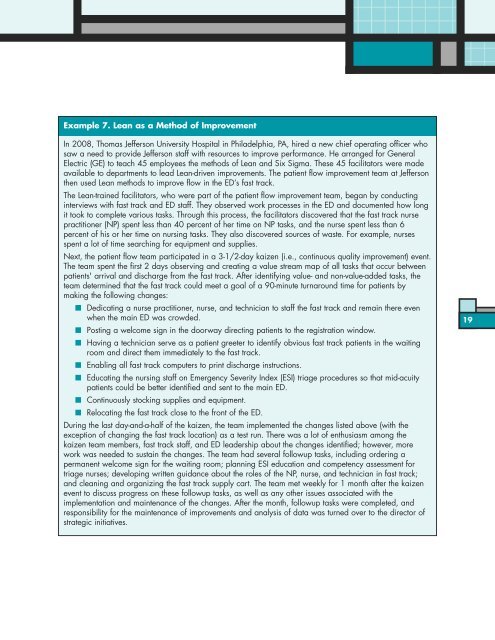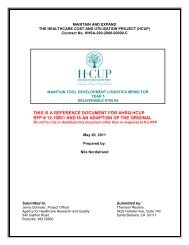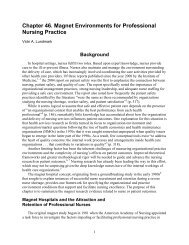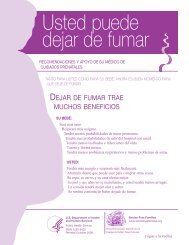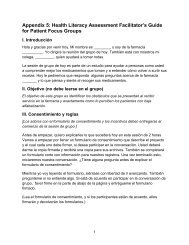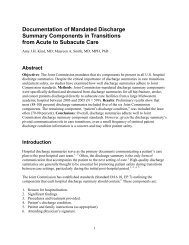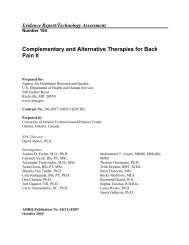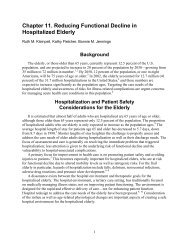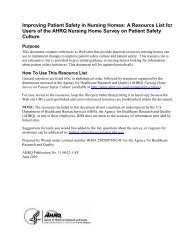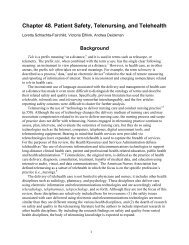Improving Patient Flow and Reducing Emergency Department ...
Improving Patient Flow and Reducing Emergency Department ...
Improving Patient Flow and Reducing Emergency Department ...
You also want an ePaper? Increase the reach of your titles
YUMPU automatically turns print PDFs into web optimized ePapers that Google loves.
Example 7. Lean as a Method of Improvement<br />
In 2008, Thomas Jefferson University Hospital in Philadelphia, PA, hired a new chief operating officer who<br />
saw a need to provide Jefferson staff with resources to improve performance. He arranged for General<br />
Electric (GE) to teach 45 employees the methods of Lean <strong>and</strong> Six Sigma. These 45 facilitators were made<br />
available to departments to lead Lean-driven improvements. The patient flow improvement team at Jefferson<br />
then used Lean methods to improve flow in the ED’s fast track.<br />
The Lean-trained facilitators, who were part of the patient flow improvement team, began by conducting<br />
interviews with fast track <strong>and</strong> ED staff. They observed work processes in the ED <strong>and</strong> documented how long<br />
it took to complete various tasks. Through this process, the facilitators discovered that the fast track nurse<br />
practitioner (NP) spent less than 40 percent of her time on NP tasks, <strong>and</strong> the nurse spent less than 6<br />
percent of his or her time on nursing tasks. They also discovered sources of waste. For example, nurses<br />
spent a lot of time searching for equipment <strong>and</strong> supplies.<br />
Next, the patient flow team participated in a 3-1/2-day kaizen (i.e., continuous quality improvement) event.<br />
The team spent the first 2 days observing <strong>and</strong> creating a value stream map of all tasks that occur between<br />
patients' arrival <strong>and</strong> discharge from the fast track. After identifying value- <strong>and</strong> non-value-added tasks, the<br />
team determined that the fast track could meet a goal of a 90-minute turnaround time for patients by<br />
making the following changes:<br />
n Dedicating a nurse practitioner, nurse, <strong>and</strong> technician to staff the fast track <strong>and</strong> remain there even<br />
when the main ED was crowded.<br />
n Posting a welcome sign in the doorway directing patients to the registration window.<br />
n Having a technician serve as a patient greeter to identify obvious fast track patients in the waiting<br />
room <strong>and</strong> direct them immediately to the fast track.<br />
n Enabling all fast track computers to print discharge instructions.<br />
n Educating the nursing staff on <strong>Emergency</strong> Severity Index (ESI) triage procedures so that mid-acuity<br />
patients could be better identified <strong>and</strong> sent to the main ED.<br />
n Continuously stocking supplies <strong>and</strong> equipment.<br />
n Relocating the fast track close to the front of the ED.<br />
During the last day-<strong>and</strong>-a-half of the kaizen, the team implemented the changes listed above (with the<br />
exception of changing the fast track location) as a test run. There was a lot of enthusiasm among the<br />
kaizen team members, fast track staff, <strong>and</strong> ED leadership about the changes identified; however, more<br />
work was needed to sustain the changes. The team had several followup tasks, including ordering a<br />
permanent welcome sign for the waiting room; planning ESI education <strong>and</strong> competency assessment for<br />
triage nurses; developing written guidance about the roles of the NP, nurse, <strong>and</strong> technician in fast track;<br />
<strong>and</strong> cleaning <strong>and</strong> organizing the fast track supply cart. The team met weekly for 1 month after the kaizen<br />
event to discuss progress on these followup tasks, as well as any other issues associated with the<br />
implementation <strong>and</strong> maintenance of the changes. After the month, followup tasks were completed, <strong>and</strong><br />
responsibility for the maintenance of improvements <strong>and</strong> analysis of data was turned over to the director of<br />
strategic initiatives.<br />
19


